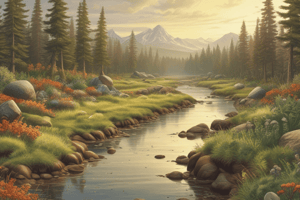Podcast
Questions and Answers
Что такое фотосинтез?
Что такое фотосинтез?
- Процесс, в котором зеленые растения преобразуют солнечный свет, воду и углекислый газ в глюкозу, выделяя кислород в качестве побочного продукта (correct)
- Процесс, в котором растения поглощают воду из почвы
- Процесс, в котором растения выделяют углекислый газ
- Процесс, в котором животные поглощают питательные вещества из растений
Что такое пищевые цепи?
Что такое пищевые цепи?
- Процесс, в котором растения поглощают питательные вещества из почвы
- Процесс, в котором растения выделяют кислород
- Процесс, в котором животные выделяют углекислый газ
- Взаимоотношения между организмами в сообществе, иллюстрирующие динамику взаимоотношений хищник-жертва и круговорот питательных веществ (correct)
Что такое эрозия почвы?
Что такое эрозия почвы?
- Процесс, в котором животные поглощают питательные вещества из растений
- Процесс, в котором почва разрушается под действием природных сил, таких как ветер и вода (correct)
- Процесс, в котором растения выделяют кислород
- Процесс, в котором растения производят органические соединения
Что такое круговорот питательных веществ?
Что такое круговорот питательных веществ?
Что такое почвообразование?
Что такое почвообразование?
Что такое первичная сукцессия?
Что такое первичная сукцессия?
Какие животные являются переносчиками пыльцы для опыления растений?
Какие животные являются переносчиками пыльцы для опыления растений?
Как затопления способствуют биоразнообразию и формированию местообитаний?
Как затопления способствуют биоразнообразию и формированию местообитаний?
Что такое опыление?
Что такое опыление?
Какова роль гербиворов в экосистемах?
Какова роль гербиворов в экосистемах?
Flashcards are hidden until you start studying
Study Notes
Natural Processes
Natural processes refer to interactions among organisms, their environments, and the movement of nutrients and energy. They play a crucial role in creating and shaping natural communities. Some natural processes, like photosynthesis and pollination, occur at the scale of individual plants, while others, such as the water cycle or soil formation, can impact entire ecosystems. Here's a closer look at a variety of natural processes:
Energy Flow and Nutrient Cycles
Photosynthesis
Photosynthesis is the process by which green plants convert sunlight, water, and carbon dioxide into glucose, releasing oxygen as a byproduct. It is responsible for producing most of the planet's organic compounds and is essential for sustaining life.
Food Webs
Food webs describe the relationships between organisms in a community through feeding habits. They show how energy flows from one organism to another, illustrating the dynamics of predator-prey relationships and nutrient cycling.
Sediment Transport and Soil Formation
Soil erodes due to natural forces like wind and water, and sediments accumulate over time to form layers, eventually leading to soil formation. This process involves the interaction of organisms, air, water, and minerals, resulting in unique soil properties and landscapes.
Reproduction and Regeneration Mechanisms
Some plants and animals reproduce sexually, requiring mating between individuals to exchange genetic material for offspring, while others reproduce asexually, generating new generations directly from existing adults. This diversity ensures the continuation of species populations.
Natural Disturbances
Fires
Fire plays a vital role in some ecosystems, breaking down dead plant material and returning nutrients to the soil. Certain plant species rely on periodic fires for reproduction and survival.
Floods
Floods can deliver nutrients and create suitable habitats for certain aquatic plants and animals. They help shape river banks and wetlands, contributing to biodiversity and habitat formation.
Succession
Succession refers to changes in a community's composition and structure over time. Primary succession occurs in newly formed habitats, while secondary succession follows environmental disturbance in established habitats. In both cases, pioneer species colonize the area, eventually giving way to more diverse and productive communities.
Plant/Animal Interactions
Pollination
Pollination is the transfer of pollen grains from the male part of a flower to its female part, usually by insects, birds, mammals, or winds. This process allows for plant reproduction and seeds to grow.
Herbivory
Herbivores feed on plants, playing a significant role in regulating plant populations. They can facilitate plant adaptation and lead to co-evolution between plants and herbivores.
Seed Dispersal
Many plant seeds rely on animals, wind, or water to travel to new locations, ensuring their survival and allowing for establishment in new habitats.
Climate and Microclimate
Climate influences the distribution and abundance of species, as well as the overall productivity of ecosystems. Local factors like temperature, precipitation, and humidity can create distinct microhabitats, promoting variation in species composition and function.
These natural processes are interconnected and work together to create complex ecosystems with diverse habitats and species distributions. Understanding these interactions is crucial for predicting the impacts of environmental changes on biodiversity and ecosystem services.
Studying That Suits You
Use AI to generate personalized quizzes and flashcards to suit your learning preferences.




